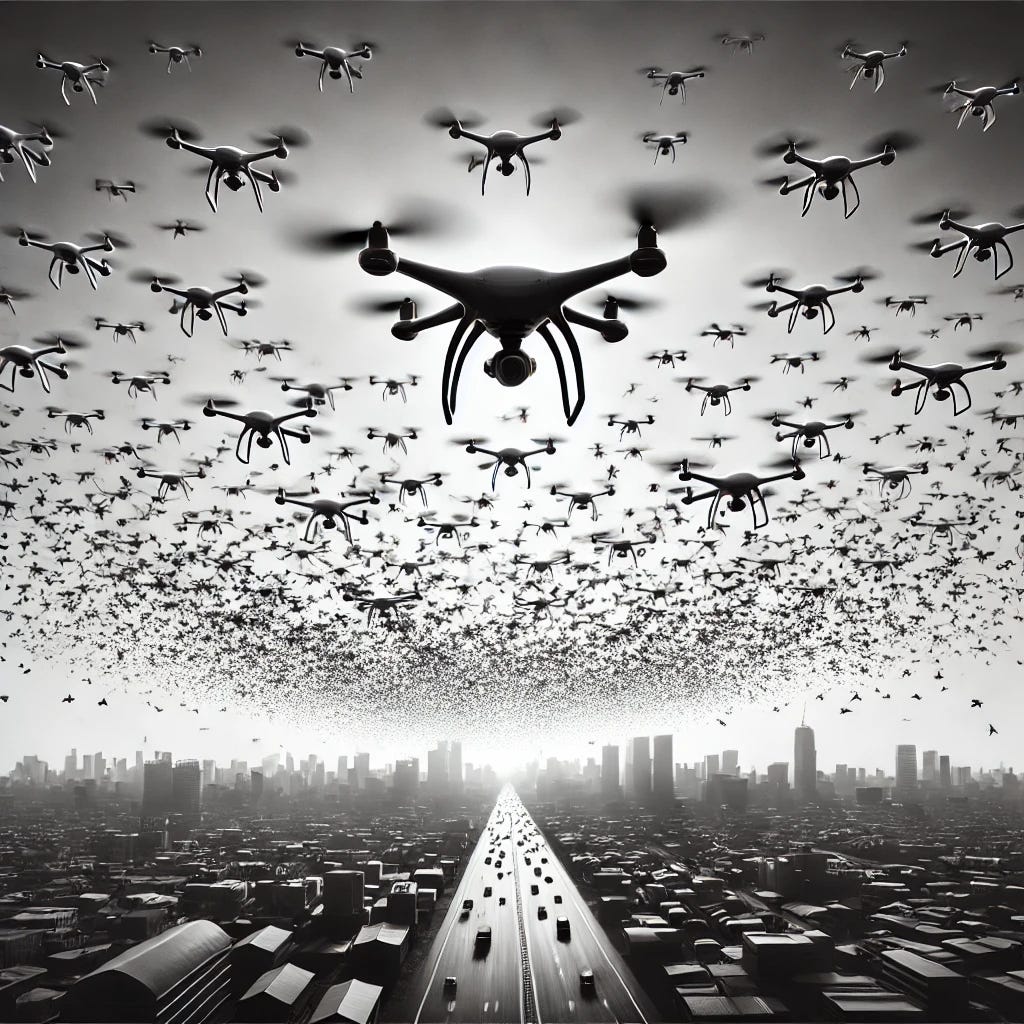Imagining Drone Swarm Attacks on Civilian Targets
Unanticipated Scenarios
As drone technology advances at a rapid pace, the potential for its misuse grows equally fast. Not only confined to military applications, drone swarms could pose a significant threat to civilian life. These autonomous and coordinated fleets of drones can carry out complex and devastating attacks, from disrupting large public events to targeting critical infrastructure. In this post, we explore various scenarios where drone swarms could be used against civilians, highlighting the urgent need for robust countermeasures and regulatory frameworks to address this emerging threat.
Signs
Drone swarm technology has rapidly advanced and is being increasingly integrated into military strategies and tested for various applications. Here are some real-world indicators of this growing threat:
Military Use in Conflict Zones: The war in Ukraine has seen significant use of drone swarms by both Russian and Ukrainian forces. These swarms have been used to strike military and civilian targets, demonstrating their effectiveness and low cost. This has forced changes in traditional military tactics, as drones are now a constant threat on the battlefield.
NATO's Defensive Measures: NATO is actively developing and testing systems to counter drone swarms, recognizing their potential to overwhelm traditional defences. Exercises involving integrated air and missile defences show the urgency of preparing for drone swarm attacks.
Autonomous Attack Drones: The U.S. military is working on autonomous drone swarm systems that can carry out complex missions with minimal human oversight. These systems, designed to disrupt and destroy enemy targets, include capabilities for launching smaller drones to execute coordinated attacks.
Civilian Applications and Risks: Commercial availability of drone swarm technology means that these systems can be adapted for malicious purposes. Small, commercially available drones have been retrofitted with explosives for use in conflict zones, indicating the ease with which they could be used in terrorist attacks.
Scenario 1: Stadium Panic: When Drone Swarms Disrupt Major Sports Events
Current State
A high-stakes football match at a stadium with over 60,000 attendees. Security measures include metal detectors, bag checks, and a limited number of armed guards.
Attack
Infiltration: 100 drones, each the size of a small bird, fly over the stadium's open roof. These drones carry smoke grenades and loudspeakers.
Execution: As the game reaches halftime, drones release smoke to obscure visibility and play messages causing panic about a supposed bomb threat.
Chaos: Spectators rush to exits, leading to stampedes and injuries. The smoke and panic cause further confusion, making it difficult for security to respond effectively.
Long-term Impact
Policy: Implementation of mandatory drone jammers and detection systems at all large public venues.
Public Perception: Heightened anxiety around attending large events, impacting ticket sales and attendance.
Technology: Rapid advancement in counter-drone technology, with new startups emerging focused on drone interception and neutralization.
Scenario 2: Citywide Blackout: Drone Swarms Targeting Power Grids
Current State
A major city's power grid, heavily reliant on centralized power stations, has basic security and surveillance systems in place.
Attack
Swarm Deployment: At midnight, a swarm of 200 drones carrying EMP devices and small explosives converge on the city's main power stations.
Destruction: The drones execute synchronized attacks, disabling surveillance systems with EMP blasts and then detonating explosives on key transformers.
Immediate Response: Power outages ripple across the city, plunging millions into darkness and disrupting emergency services.
Long-term Impact
Infrastructure Security: Government mandates for all critical infrastructure to install advanced anti-drone defence systems.
Policy and Regulation: Stricter drone manufacturing regulations and mandatory registration of all drones with tracking systems.
Innovation: Development of decentralized power grids and microgrids to mitigate the impact of such attacks.
Scenario 3: Urban Chaos: Coordinated Drone Swarm Attacks in Major Cities
Current State
An urban area with a population of 5 million, including high-rise buildings, public transportation systems, and crowded markets.
Attack
Multiple Swarms: Three swarms, totaling 500 drones, each equipped with facial recognition and small explosives, are released from different points around the city.
Execution: The drones target public transport hubs, markets, and government buildings, coordinating to strike simultaneously.
Response: The attacks lead to widespread panic, with emergency services struggling to respond effectively due to the scale and coordination of the assault.
Long-term Impact
Urban Defence: Cities deploy automated drone defence grids capable of detecting and neutralizing drone threats in real-time.
Public Awareness: Increased public awareness and preparedness drills for drone attack scenarios.
International Cooperation: Enhanced global treaties and cooperation on drone technology regulation and anti-terrorism measures.
Scenario 4: Data Breach: Drone Swarms Compromising Critical Infrastructure
Current State
A remote yet critical data center that houses servers for a major financial institution. Security includes fences, cameras, and a small on-site security team.
Attack
Stealth Approach: A swarm of micro-drones, each the size of an insect and equipped with hacking devices, bypasses the physical security undetected.
Data Breach: The drones infiltrate the facility, accessing servers and planting malware to extract sensitive financial data.
Delayed Response: The breach isn't detected until abnormal network activity is noticed, by which time significant data has already been compromised.
Long-term Impact
Cybersecurity Enhancements: Financial institutions invest heavily in advanced cybersecurity measures and drone detection technologies.
Regulatory Changes: New laws requiring data centers to have integrated physical and cyber defence systems against drone threats.
Market Shifts: Growth in the cybersecurity and drone defence sectors as companies rush to protect their data assets.
These scenarios illustrate the diverse and potentially devastating impacts of drone swarms on civilian life, highlighting the urgent need for advanced countermeasures and proactive policies to address this emerging threat.


